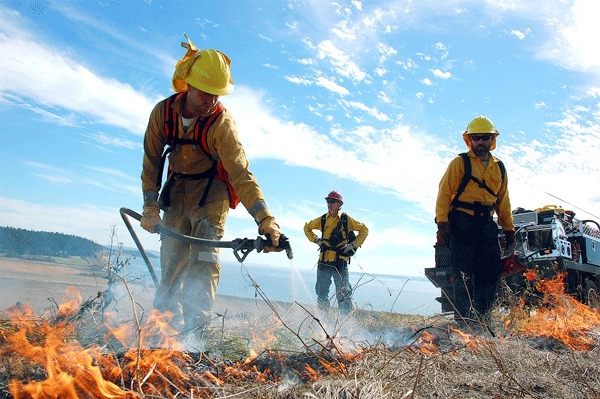Fires dotted prairie land in Ebey’s Landing National Historical Reserve last week, but they were not the result of criminal mischief or a stray cigarette butt.
Researchers from the University of Washington were back in Central Whidbey for the second year in a row Sept. 3, conducting a project that, if successful, could bring back some of the area’s most colorful but long-lost insect species. They are hoping to lure butterflies.
“That’s ultimately what’s at the foundation of this project,” said Eric Delvin, a community conservation coordinator with The Nature Conservancy and a graduate student at UW working on his doctorate in ecology.
Delvin, one of several project leaders, said the purpose is to study techniques that restore prairie lands to their native state, which are believed to have supported at least five species of butterflies: Taylor’s checkerspot, the island marble, the Mardon skipper, the Puget blue, and the valley silverspot.
The three-year project is being funded largely by about $220,000 in grants from U.S. Fish and Wildlife and is taking place in several locations around Puget Sound. In Central Whidbey, burns were conducted at the Pacific Rim Institute and above Ebey’s Landing near the historic Jacob Ebey House.
The sites were selected because they are either near existing “remnant” prairie — grassland with a high concentration of native plants — or because it’s an area where it used to exist. There are very few remaining remnant prairie areas in Western Washington; most of it has been destroyed by centuries of agriculture by settlers.
“There are very few left so what we are trying to do is create new prairies,” said Jon Bakker, a project leader and assistant professor of restoration ecology and management at UW.
That loss of habitat is believed to be the major contributor to the disappearance of these butterfly species. While the focus is their reintroduction, the project is also designed to test and evaluate what methods of restoring native prairie work best, Bakker said.
Beginning in 2009, Delvin, Bakker, and Peter Dunwiddie, another project leader and an associate faculty member at UW, began testing two methods on small plots of prairie in Central Whidbey.
One, called “solarization,” works by trapping heat to kill off the existing and invasive species. The soil is treated first with an herbicide, then plowed and covered with a heavy-duty plastic. The other method is simple burning. Both areas are left fallow until fall when they are seeded with native species.
So far, the results have been mixed with solarization working better at the pacific rim property while burning worked better near Ebey’s Landing. Fires tended to burn longer and hotter at Ebey’s, and may be indicative of the varied outcomes, Bakker said.
“What will really be interesting is to see what happens next year,” he said.
Data gathered after a second full cycle may be much more revealing. While the project will continue for at least one more year, possibly longer depending on available funding, Bakker and Delvin’s hope is to nail down a technique that can be applied in large areas and ultimately restore lost butterfly species.
“That’s the enchilada we’re working towards,” Delvin said.



